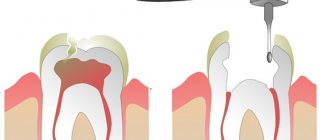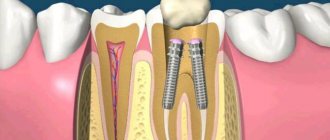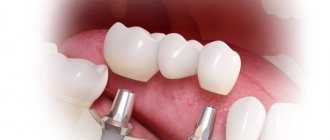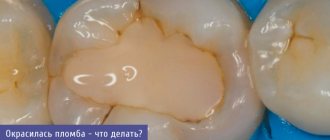Author: Salatsky Dmitry Nikolaevich Chief physician, orthopedic dentist, gnathologist, maxillofacial prosthetist When treating most dental diseases, doctors do not limit themselves to simply removing the affected necrotic tissue, cleaning out the carious cavity. Very often, the dentist’s task becomes the need to remove the pulp, the neurovascular bundle located inside the tooth, and clean it with further filling of the tooth canals (endodontic treatment). In this case, the dentist must go through all the canals in the tooth without exception, since the anatomical space inside the dental unit remaining uncleaned and unsealed can lead to irreversible consequences due to which it will have to be removed.
Causes of obstruction of dental canals
The root canals of teeth can become obstructed for a variety of reasons. The most common include:
- features of the anatomical structure of the tooth - highly curved roots with small branches, flattened areas and transverse bridges;
- inflammatory processes in the neurovascular bundle - with dental injuries and chronic pulpitis with a subacute course, the root canals can become overgrown;
- age-related changes in tissues - over time, dentin deposits accumulate on the walls of the root canals, which lead to a narrowing of the lumen;
- dental procedures using phosphate cement - this material has a high density and cannot be destroyed by ultrasonic waves, instruments and solvents.
Before starting endodontic treatment, it is important to accurately determine whether the canals are patent.
Why and when is root canal treatment required?
Extensive caries, pulpitis, periodontitis are dental diseases that bring painful suffering to a person and require serious endodontic treatment, which consists of cleaning and filling the canals. Sometimes dentists ask whether it is possible not to fill the canal in case of these diseases. As experts state, this complex canal treatment is necessary and should only be carried out under a microscope, because Only with its help can you fully save the tooth, its functionality and aesthetics. All manipulations performed inside the canals must be carried out by the dentist with increased precision, however, even if the surgical intervention went without incident, not a single person is insured that after some time he will not experience the consequences of such treatment.
Deputy chief physician
Brodsky Sergey Evgenievich
Sign up for a free consultation
+7
All complications of endodontic manipulations are directly related to improper treatment of canals in the teeth and are of the following nature:
- There are no channels found. This situation is possible if the dentist works without a microscope and cannot find the tooth canal because it is additional, too narrow or has an atypical anatomical entrance. When a doctor, due to inexperience or due to the lack of necessary equipment in the clinic, leaves hidden or atypical, too narrow canals in the tooth uncleaned, the inflammatory process begins to develop again in them after a short time.
- The canals are poorly sealed. This consequence of medical manipulations is due to the fact that the dentist discovered narrow canals in the teeth, which is why he was unable to fill them to their entire length. The remaining voids become the site of localization of pathogenic microflora,
- The entire length of the dental canals were not cleaned. It is impossible to completely go through the tooth canal in several cases:
- during repeated endodontic treatment, the dentist cannot remove the remaining fillings from phosphate cement, a very durable material that cannot be removed by mechanical means, solvents and ultrasound;
- age-related changes - with age, the walls of the canals become covered with deposits of dentin-like tissue and dentin, which leads to their narrowing.
- chronic and subacute pulpitis or regular overloads provoked the overgrowth of canal cavities;
- The canals are washed with antiseptics very quickly, without recording the exact time of exposure, and this leads to the fact that the bacterial microflora located in them does not have time to die and provokes the occurrence of repeated inflammation.
The listed consequences speak for themselves about what will happen if one of the canals is not sealed. To prevent repeated inflammation that can lead to tooth loss, dental procedures should only be performed by a qualified dentist with extensive experience. It is precisely these specialists who work in the Moscow clinic Partner-Med, so endodontic treatment of teeth there is guaranteed to end in their salvation.
Canal treatment technique
Questions about how exactly dental canal treatment occurs in order to preserve the dental unit are also of interest to many people. This type of therapy involves the use of various methods, but they all have a standard treatment regimen, which consists of 3 stages and looks approximately like this:
- Providing access to the canal cavity.
- Expansion and formation of the causal channel.
- Complete cleaning of the dental canals from necrotic tissue.
- Permanent sealing with inert material guaranteeing complete sealing.
Manipulations for canal treatment can be compared to a microsurgical operation, because all manipulations are carried out on a microscopic area that has poor visibility for the dentist. These factors require high professionalism and precision from the dentist, so root canal treatment should be carried out only under a microscope and requires a responsible choice of dentistry. A dental clinic must have a dental microscope, without which endodontic treatment is significantly complicated.
Why choose Partner-Med for dental canal treatment
Our clinic has a large number of advantages over other Moscow dentists, so a large number of residents of the capital prefer to get rid of dental problems with us. Reviews from our patients indicate that the following factors play an important role in choosing our clinic:
- free initial appointment;
- constant promotions and discounts on services;
- adequate prices for treatment and a flexible payment system;
- high level of education and many years of experience of our specialists;
- We specialize in endodontic dentistry with the mandatory use of dental microscopes;
- the use of only modern technologies and innovative equipment in all dental procedures.
Just pick up the phone and call us!
+7
We will definitely make you an offer that you cannot refuse!
Diagnostics
Treatment of impassable root canals begins with determining their length and anatomical features. The most informative diagnostic method is radiography. To obtain accurate data on the condition of the tissues, a photograph of the tooth root is taken with the instrument inserted into it. This allows you to see:
- length of root canals,
- the presence of curvatures and perforations,
- impassable areas.
The condition of the periodontium is also assessed. This allows you to determine further treatment tactics.
Methods for filling root canals
The list of root canal filling methods is constantly updated, combining the advantages and features of the previous ones. Here are some that are loved by doctors and used most often.
Before obturation of the root canal, be sure to thoroughly wash and dry the canal with paper points.
Lateral condensation
Lateral condensation is widespread among doctors and can be called classical.
Spreader selection
It starts with choosing the necessary tools - a spreader. It, like all endodontic instruments, has its own marking, so we can choose the size we need according to the Master-file size. The spreader can be made of NiTi alloy or stainless steel. The choice depends on the individual root canal anatomy. When inserted into the root canal, the spreader should be placed over the entire working length of the canal and removed from it with light force.
Features of treatment
Various techniques are used to treat impassable root canals:
- devital amputation of the pulp followed by mummification,
- depophoresis.
A special approach is required if the root canal:
- strongly curved
- completely closed,
- narrowed,
- is located next to the neighboring root.
To make the canal passable along its entire length, modern dentistry uses:
- durable extractors - nickel-titanium files, which allow you to go through the canal without preliminary tooth preparation;
- drills - special instruments with spiral blades designed for quick and safe removal of gutta-percha, pastes, cements and other filling materials;
- solvents - necessary for unsealing previously sealed canals; they cope well with soft and plastic materials.
The treatment tactics for impassable root canals in each clinical case are determined by the doctor. The procedure is performed under anesthesia. Depending on the complexity, treatment is carried out in one or several stages. To obtain the desired result, 2-3 visits to the dentist may be required.
Principles of Root Canal Preparation and Treatment
There is not a single dentist I know who does not have teeth in their daily practice that require root canal therapy (RCT; endodontic treatment) (eg, severe pain, deep caries, treatment planning for prosthetics). Or teeth that have undergone endodontics and require further root canal treatment (for example, post-endodontic augmentation, placement of fiber posts, tooth preparation for prosthetics, orthodontic extrusion, etc.)
Author: Calogero Bugea
Although endodontics is a specialty that requires extensive training, study of canal curvature and specific instrumentation, each of us must practice this discipline by following a few simple basic rules. This is necessary to improve success rates in root canal therapy (RCT), reducing endodontic operative time and patient stress.
On the other hand, the endodontist must be able to perform proper composite restorations, crown lengthening, etc., to facilitate the work of colleagues who will continue to care for the patient after endodontic treatment.
To facilitate complex treatment, it is very important to follow these simple rules.
Photo 1.
Removing plaque and tartar
Presence of plaque and tartar. Patients come to the dental office either to begin restorative treatment or for pain relief. Obviously, even when it comes to endodontics, working with healthy tissue is better than working with inflamed tissue; work without dental plaque will be of much higher quality. Dental dam placement and restorative procedures are much easier to perform in a healthy mouth, which in turn provides a cleaner, safer environment for the clinician to work in. In the case of acute pain, even if the main purpose of the visit is obviously to relieve it, we should always think about the next steps to take: Scaling the work area only takes a few minutes and improves the workflow. Of course, visiting a hygienist is a must to reduce bacteria counts. This simple step plays a fundamental role in subsequent restorative procedures.
Photo 2.
Treatment of caries
Treatment of caries. It is extremely important to treat tooth decay before undergoing endodontic treatment. Complete cleaning of the cavity before starting paintwork is a prerequisite for working in the cleanest possible environment.
Photo 3. Preliminary restoration before endodontics. In general, pre-restoration can be avoided if you complete the treatment in one visit. If you believe that you will not be able to complete endodontics in one session or when a complication arises during treatment, you must create a perfect access seal. Schilder said: “It is more important what you have than what you do”; The evolution of this concept is that it is better to protect the endodontic space than to fill it with paste.
Photo 4. Leaving the tooth open only in case of pulpitis or necrosis is really the wrong approach; bacteria can enter the root canal system and the biofilm will subsequently be very difficult to remove.
Photo 5. A bad temporary restoration is the same as leaving a tooth exposed.
Photo 6. Elimination (filing) of the bumps is mandatory in case of cracks, and this is the first step. The risk of a crack being created and/or spreading between two visits is very high. In general, all endodontically treated teeth require an indirect restoration or crown. For this reason, having a flat surface as a reference point makes it easier for younger colleagues to measure the working length of the canals in comparison with cusped teeth.
Photo 7.
Preparation of the pulp chamber
Cleaning the pulp chamber. Sometimes it happens that when I restore teeth previously treated by a colleague, I find a dirty pulp chamber. My only thought in these situations is: WHY?
Photo 8. The walls of the pulp chamber must be cleaned instrumentally, with an air abrasive or with a bur. The podiatrist or other colleague should work in a clean space. To treat the surface, you need to use a simple silicone head. The tooth is then ready for adhesion procedures.
Photo 9.
Pin placement
It is recommended to prepare the space for the post after root canal treatment. Thus, prosthodontists should only assess the postoperative field and, only if necessary, renew the dentin and proceed to adhesive procedures.
Photo 10. In this case, I advised placing only one pin. After visiting the orthopedist, the patient returned due to pain. I noticed a perforation in the MB2 channel due to improper preparation of the space for the pin. I closed the MTA perforation and the pain resolved within a week.
Photo 11.
Temporary materials
Cotton sponges and temporary materials. About 90% of my cases result in final restoration. This allows colleagues who continue dental treatment to apply a composite restoration or install an orthopedic crown. In the other 10% of cases, I use only curing materials that are able to perfectly adapt to the edges of the canals, thereby preventing plaque from entering the treated spaces.
Photo 12. External seal of the endodontic space. The most common mistake at the end of endodontic treatment, even if a second visit is scheduled, is not sealing your own work.
Photo 13. Temporary marginal adaptation. The same concept should be used for the restorative phase: the overlap and invasion of the operated gingival space, as well as the rough adaptation surface of the temporary restoration, create an ideal place for bacterial growth.
Photo 14: I prefer to use Teflon with the cured temporary filler because it is easier than cotton sponges to completely remove before adhesion procedures.
Photo 15. Even if you are not an endodontist, as a dentist, you need to know the basic rules of treating the patient, respecting the endodontic spaces and correctly (from the point of view of endodontics), opening the pulp chamber and not leaving the tooth with a poor restoration.
Photo 16: If you are actually an endodontist, you should know what the next clinical step is. In this case, the tooth was prepared for crown restoration the next day, so there was no point in creating the exact anatomy of the tooth during restoration, as well as the correct point of contact with neighboring teeth. After endodontic treatment, it took only 15 minutes to properly prepare the tooth for prosthetics.
conclusions
Dentists sometimes work hard, but forget the basic rules in order to reduce the time of surgical interventions, for themselves and for other colleagues. In the following article we will describe, step by step, clinical procedures for increasing success in these stages of treatment.
The translation was carried out by S. Filanovich specifically for the OHI-S.COM website. Please, when copying material, do not forget to provide a link to the current page.
https://www.styleitaliano.org/
How channels are processed
The effectiveness and duration of endodontic treatment depends on the method of canal treatment chosen by the doctor, namely:
- Manual - cleaning using special tools; the process is lengthy and tedious not only for the patient, but also for the doctor.
- Mechanical - cleaning using nickel-titanium tools and an endomotor; Much faster and more efficient than manual cleaning, it allows you to clean even curved channels well.
- Ultrasonic – cleaning using an ultrasonic scaler; special endodontic attachments make it possible to easily remove remaining pulp and quickly expand narrow canals; with the help of such attachments, it will not be difficult to free the canal from old gutta-percha or remove a broken instrument.
Most experts agree that high-quality irrigation of dental canals can only be achieved by combining different methods.
Important! In our clinic, the endodontist has the opportunity to use mechanical and passive ultrasonic cleaning in his practice, which, in combination with competent medicinal treatment of the canal with special disinfectants, ensures a 100% result.
The main principle of qualified endodontic treatment is the use of a microscope, which allows, under multiple magnification, to achieve the necessary efficiency of treatment, thorough disinfection and sealing of canals.
To control the quality of the work done during treatment and after its completion, control images must be taken to exclude the possibility of complications.
If your tooth hurts after root canal cleaning
Toothache is an acceptable consequence of endodontic treatment; provided that all doctor’s instructions are carefully followed, the pain should gradually go away within three days.
If the pain does not go away within three days (and even earlier, if the intensity of the pain increases), a repeat visit to the clinic is necessary. This is possible, for example, with periodontitis, when even high-quality canal treatment is not enough and further treatment is necessary.
Important! Only a doctor can prescribe adequate treatment (medical or surgical) after diagnosis; self-medication is extremely dangerous!
In conclusion, here are some tips for choosing a clinic for endodontic treatment. When choosing dental services, pay attention to the following points:
- Quality of the initial consultation: this should be a thorough examination of the oral cavity and the most detailed interview of the patient, who should be given the opportunity to learn about the state of health. Already at this stage, the doctor must demonstrate his ability to create a comfortable environment and win over the patient.
- The quality of the proposed diagnosis: the patient should be offered an X-ray examination; canal treatment should be preceded by a computed tomography scan, which allows one to accurately determine the number of canals to be treated in the tooth.
- Use of latex plates in practice (read about the purpose of rubber dam above).











